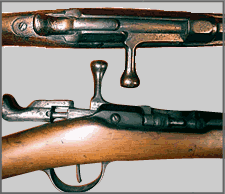- 01: Introduction
- 02: History
- 03: Propellants, Firearms, and Ammunition Development
- 04: Modern Firearms Manufacture
- 05: Small Arms Ammunition
- 06: Evidence Handling Procedures
- 07: Equipment and Instrumentation
- 08: Examination of Firearms
- 09: Cartridge and Shotshell Examination
- 10: Characterization and Evaluation of Fired Projectiles
- 11: Bullet Comparison and Identification
- 12: Gunshot Residue and Distance Determination
- 13: Toolmark Identification
- 14: Communicating Results
- Resources


Bolt Actions
Home > Propellants, Firearms, and Ammunition Development > Evolution of Firearms > Breech Loading Firearm Design > Bolt Actions
Another basic action design that ultimately provided military applications was the turn-bolt action. Known today as bolt action, it copied the principle of the locking bolt on a door. The door bolt has a rod with a handle attached. When the handle is in one position, the bolt is free to move back and forth. In another position, the handle falls into a slot to keep the bolt locked forward. The firearm action works nearly identically. Early bolt-action firearms were locked for firing when the root of the bolt handle was closed against the receiver. Rotating the bolt handle 90 degrees unlocked it, and pulling it back made the chamber available.

Bolt action rifle
The French Chassepot Model 1866 is an excellent example of an early military bolt action firearm. It displays the rudimentary bolt action with its primitive bolt handle locking the action.
Although modern bolt actions are much improved, the basic design remains the same. The rod-shaped bolt is compact, producing a narrow side-to-side profile for the rifle. The shape of the bolt equally distributes thrust forces; this was improved upon in later designs. Most importantly, the stroking action used to manipulate the bolt and the extra room under the receiver and barrel set the stage for repeating bolt-action arms.
As cartridges grew more powerful, the simple locking action of the bolt handle root became less effective. The relative distance between the bolt handle and the cartridge, as well as the stress of firing, caused the bolt body to compress between the cartridge and the lock surface. For a low-power cartridge, this is not a concern. However, for a high-power cartridge, if the compression is too great, some cartridge support is lost, creating the risk of gas leaking into the shooter’s face.
The necessity of stronger locking systems led to repositioning the locking surfaces so that the bolt handle root became a backup rather than a primary locking point. Protruding lugs were placed on the bolt body and rotated into corresponding recesses when the action was closed for firing. The placement and the number of lugs varied from one design to another. The most effective designs placed at least two generous lugs just behind the bolt face (breech face), the surface against which the cartridge rests when the action is locked. In the best examples, the bearing surfaces of the lugs are approximately in the plane of the cartridge base.
Two basic designs emerged in military turn-bolt rifles: the Austrian Mannlicher and the German Mauser. Derived from the Chassepot, these bolt-action arms influenced the development of most military and sporting rifles.




